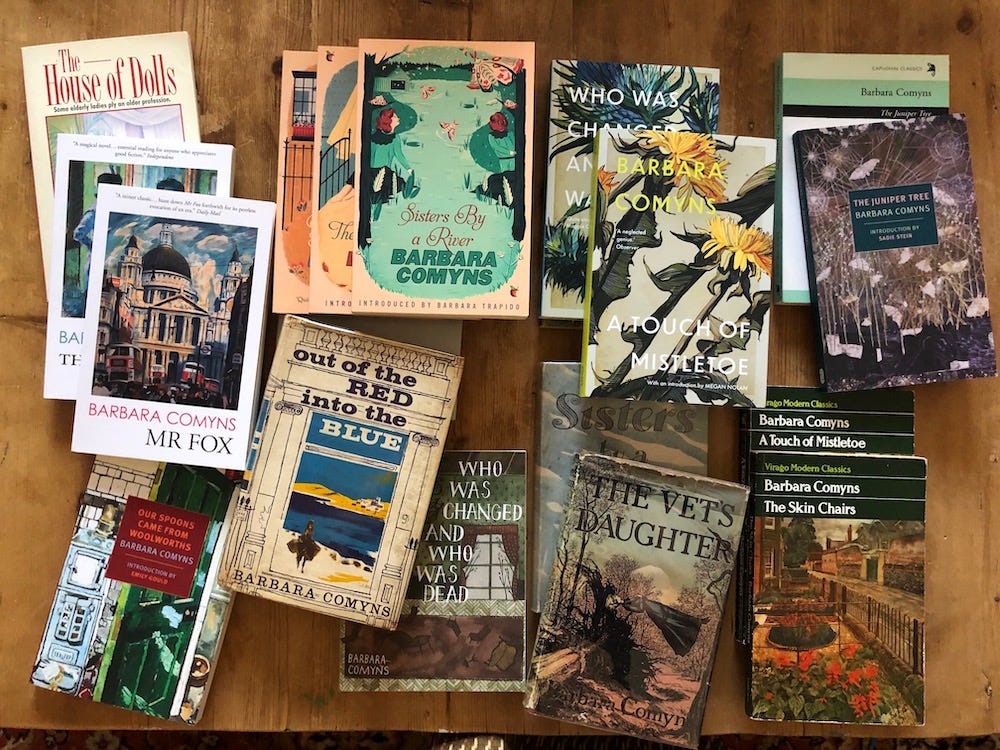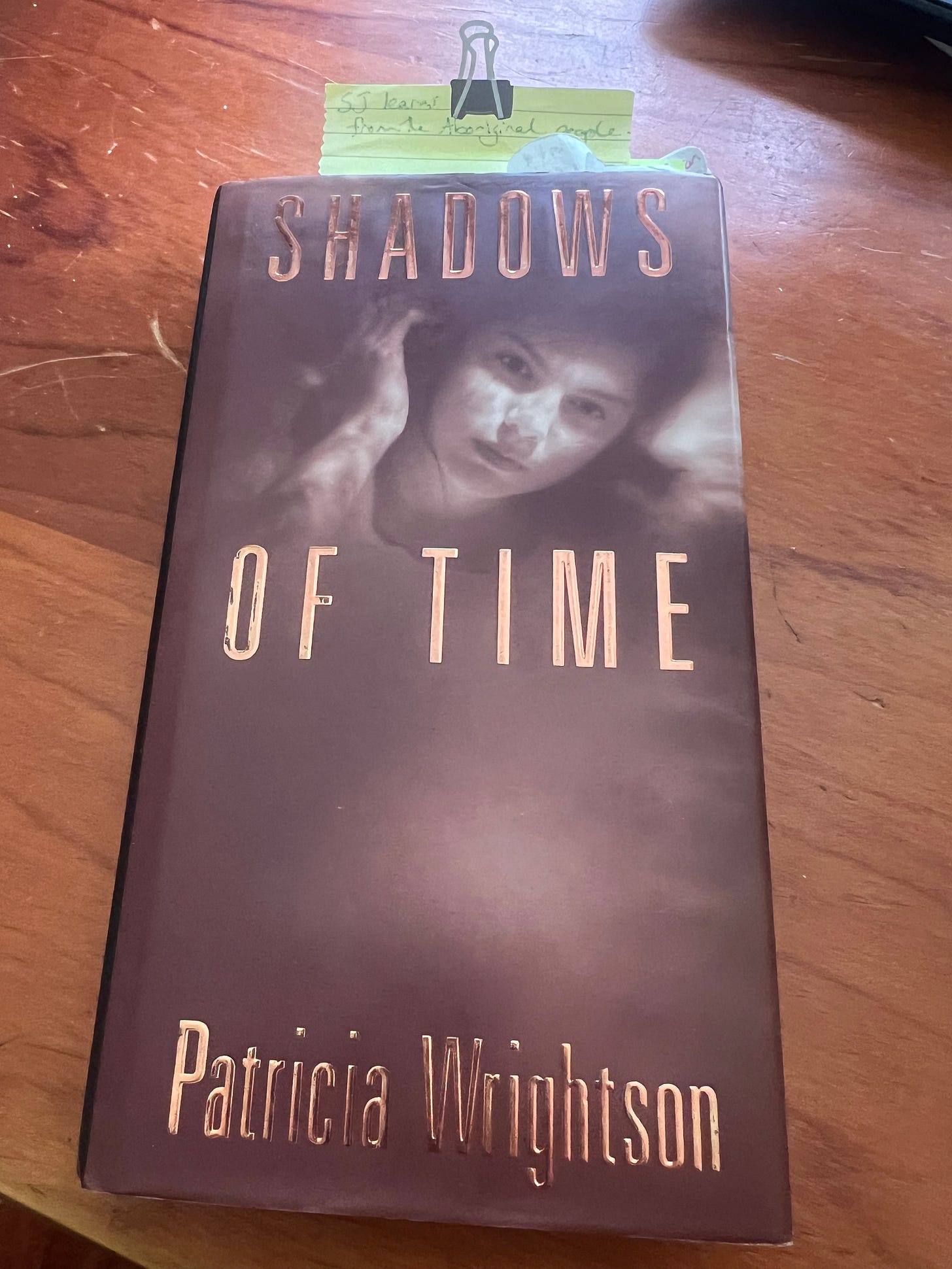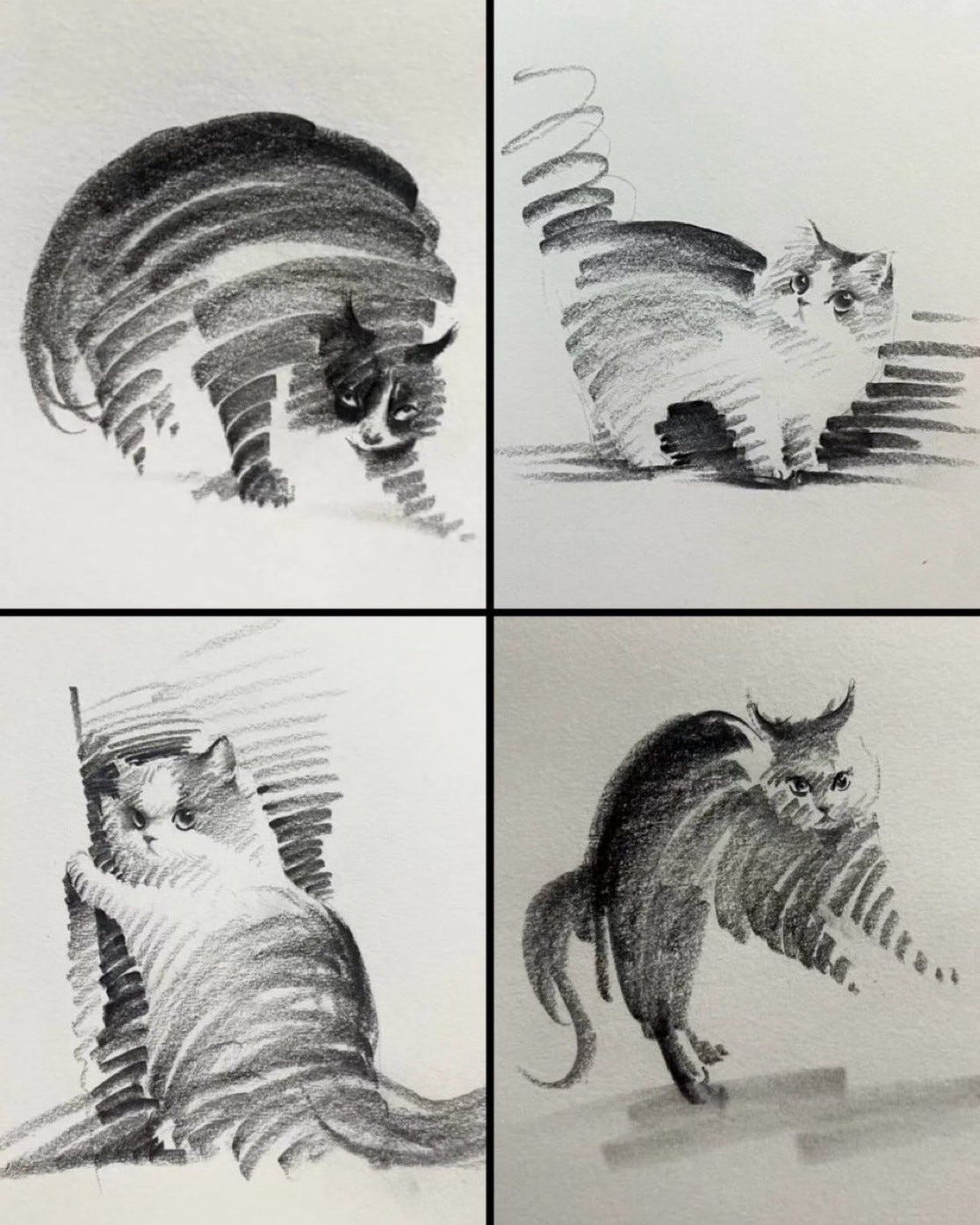Inspired by fellow substackers Simmone Howell over at oldfamiliarplaces and Stephanie Wood at Vamp, I am going to attempt a weekly roundup of things I have been reading, looking at, thinking about, inspired by and terrified over. Call it a Commonplace, a scrap book, whatever, it doesn’t matter. It will hopefully keep me posting here often enough to satisfy my own desire to do so, and hopefully feed the algorithm so that given my long breaks between posts, my substack won’t sink into complete oblivion.
Early evening sunlight streaming
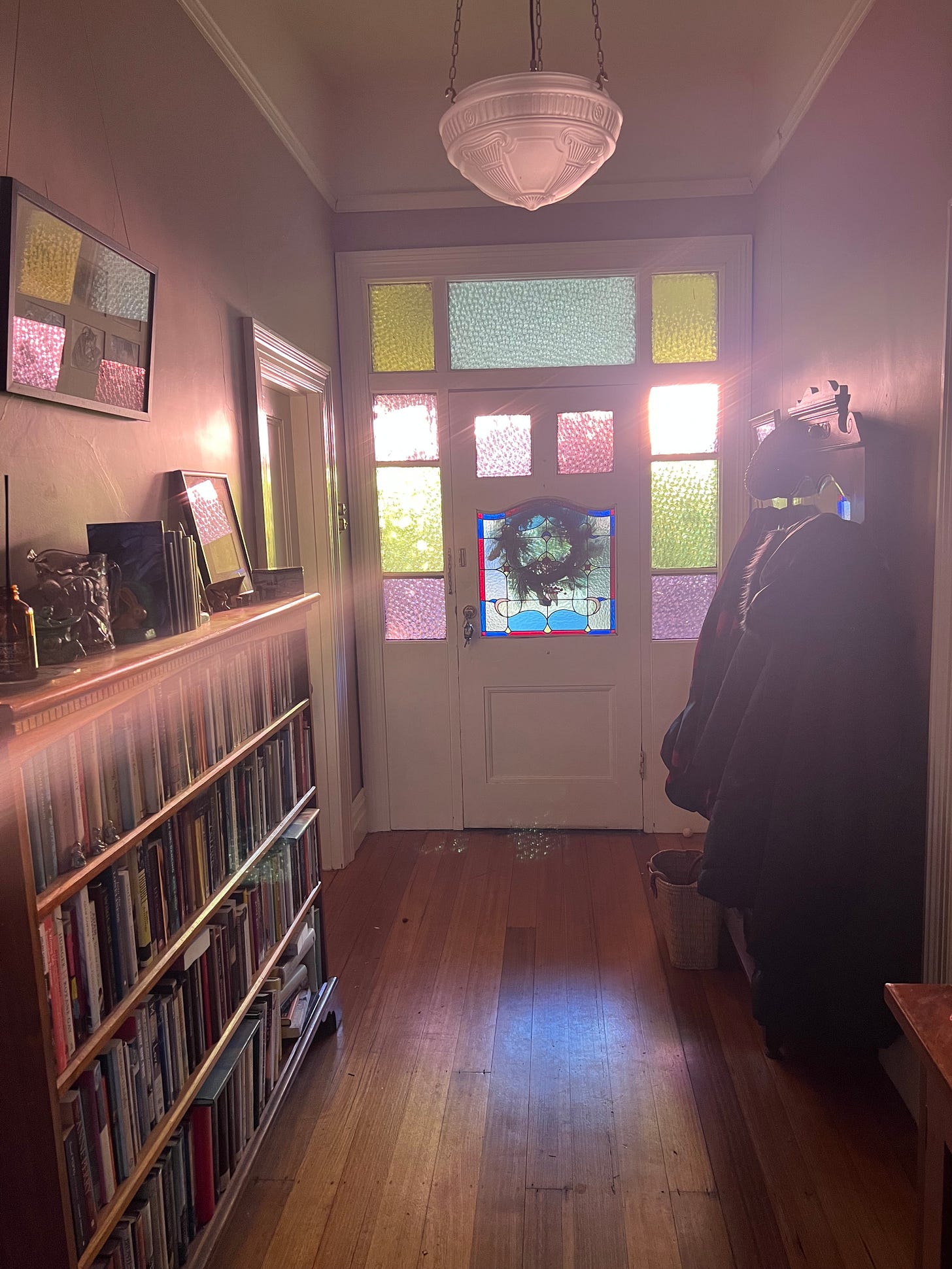
I took this photo inside my home close to 8pm the other night. My house faces west, and I get the afternoon sun straight through the front door and windows of the house. This is a bit of a problem in my office, as I tend to hit my straps with writing later in the afternoon, around the time the sun at this time of year comes straight in at eye level. I have UV film on all the windows in my house (the sun in northern Tasmania is very “burny”: despite lower temperatures than the mainland of Australia, we have very high UV) and sunscreen blinds in my study so I can still see the lovely streetscape. Even so, sometimes the sun defeats me. But the gorgeous refraction of the late sun through the coloured glass panes and leadlight in the door (not original to the house, but I love it all the same) made me so grateful, yet again, for the somewhat spontaneous decision I took last year to move here from Sydney. A friend has observed that she can see Jesus in the Christmas wreath on the other side of the door. I can see it too: and Lord, you need your foliage tidied up. (Do ya hair! as the Fashion Critical would say.)
My predecessor in the house loved purple, in all its variations. The front door is a dark purple gloss that I regret on her behalf: underneath is lovely natural timber. My painter — who helped me cover the lilac mauves in the bedrooms and the mushroom purple in the living areas — shivered in horror at the prospect of stripping it back, so I am living with it for now. We didn’t paint the hall: it’s more of a dusty rose colour, and is broken up with hallstands, bookcases and a piano left behind (yes I play, very badly). Anyway, it loaned the last rays of the sun a warmth that I hope I came some way to capturing in this photo.
Christmas is icumen in…
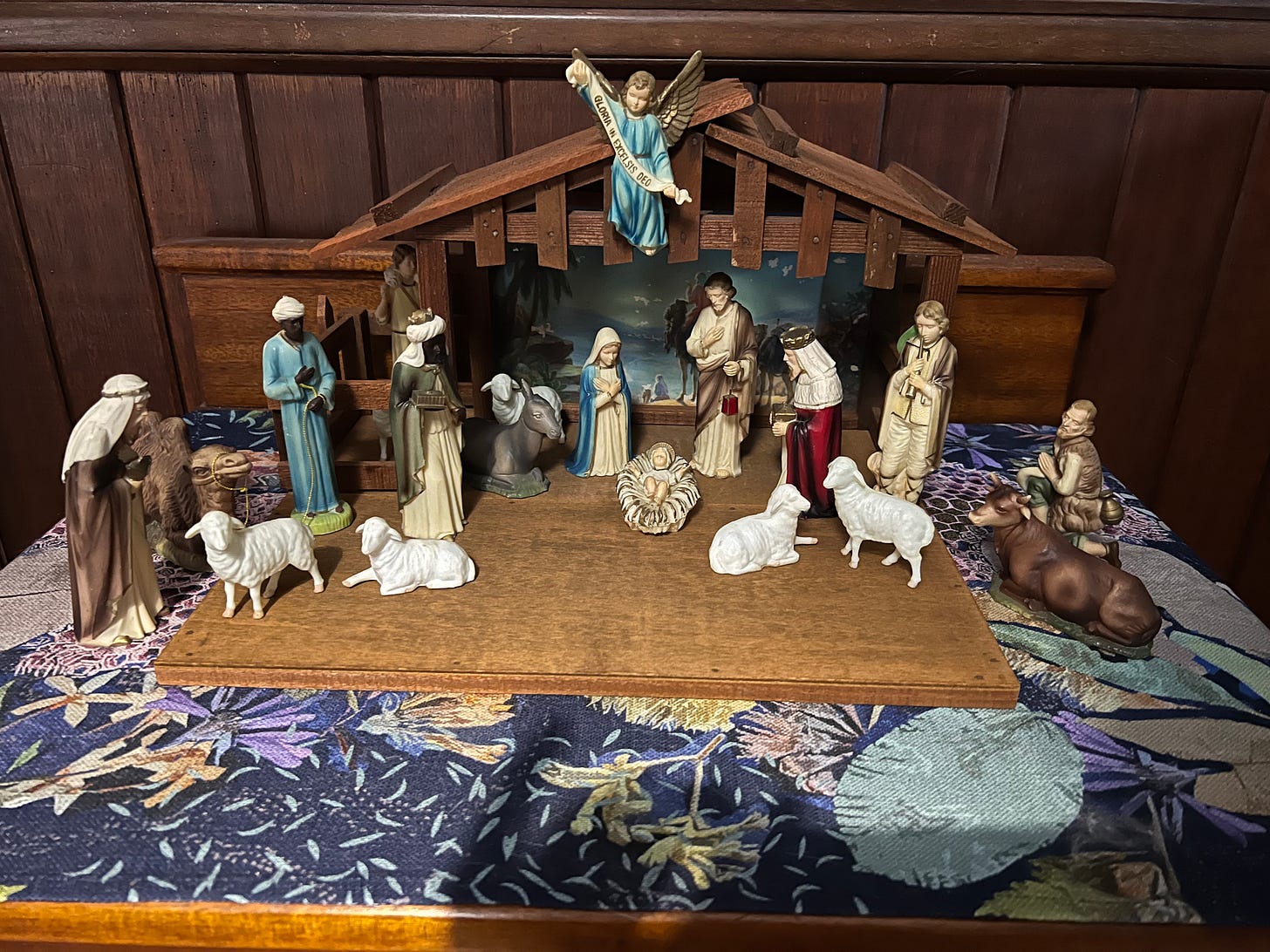
I have always loved Christmas. It was always a pretty big deal in our family. Not so much food-wise — my family are fairly plain eaters, and Mum and Dad were children of the Depression, but we did all love our Grandma Ridge’s custard and Christmas pudding with sixpences hidden inside — but of course as kids, presents and Santa were huge, and seeing our grandparents and other family members. As a church family, it was also a meaningful religious event, even if it did mean we had to wait every year for Dad to get back from leading services at various churches in the parish before we could open our presents.
I probably won’t really have a Christmas this year, although I will spend the day with friends. I have put some decorations out (but not a tree: I haven’t had a tree for 12 years because cats), and my icicle fairy lights are up on the front verandah, because I love the look of them, and it reminds me of my family. I miss our old family Christmases, and now all the niblings are grown up, and I don’t see much of the great-niblings, it’s not really the same. But still. ’Tis the season.
Current reading
Somewhere in an article or substack post recently, I read about an English author I had never heard of before. Her name is Barbara Comyns, and whatever it was I read was enough to pique my interest, so I reserved a couple of her books and a recent biography of her at my local public library. The first one I read was Our Spoons came from Woolworths, and I am currently reading Who was Changed and Who was Dead. (I haven’t cracked the bio yet.) And what a revelation she is. My mum read a lot of those Barbara Pym-style British women writers of the mid-20th Century, and I thought it would be something like that, and it kind of is. In these two books at least, Comyns peoples her novels with the kinds of characters you are familiar with from all those English novels and TV dramas and even crime fiction and latterly, detective shows, but then suddenly, she throws in a ghost or a visceral description of the condition of a cat drowned in a flash flood, or scene of such grim domestic misery that you think, well, Nanny Darling, we’re not in St Mary Mead anymore.
She’s fabulous, odd and a bit shocking. Read her.
And as always, reading for the PhD.
About to embark on a re-read of this:
Patricia Wrightson is one of the most significant and in latter-days controversial Australian children’s authors to date. She is the only Australian writer to win the Hans Christian Andersen Award for children’s literature (Australian illustrator Robert Ingeon won in the same year), but the English children’s literature scholar Brian Attebery was right when he wrote in 2005 that her “current status within Australian children’s literature is an uneasy one: she is revered but not read”1. It’s possible she’s not even all that revered any more, sadly, because of her contested use of Aboriginal spirit figures in her fantasy fiction. I’m not going to litigate a defense or otherwise of her work here, or indeed in my thesis necessarily: both positions have been well-canvassed by many scholars before me. What I am interested in is seeing how this, her final full-length novel, and the one from which she bade farewell to her “stated authorial project (which) is to encourage in white urban and rural Australians an imaginative involvement with the Australian landscape that she perceives to be currently lacking”2 works in terms of my larger thesis: how Australian fantasy writers for children have used the genre to explore a way in which non-Indigenous Australians can reconceive a relationship to Country outside of the settler colonialist constraints of fear, hostility and dominance.
Watching and re-watching
I mentioned in a Note today that I am rewatching Severance in anticipation of the second season finally arriving next month. It’s even better on a second viewing. If you haven’t seen it, I highly recommend. I don’t rewatch a lot of television, but this is rich viewing and well worth revisiting.
I’m also really enjoying the new season of Shrinking. I just really like these characters, and I care about what happens to them. I think they do a great job with balancing humour with the underlying theme of grief and loss. It feels like proper grown-up storytelling to me.
I loved Bad Sisters Season 1, and am watching Season 2 a bit through my fingers. It’s not that it’s not good, and the performances are fanastic (I have never hated a character like I hate Fiona Shaw’s Angelica), it’s just that I want them to catch a break. I don’t think that’s likely. And actually, I think I hate the young woman cop evern more than Angelica. Hope she gets her comeuppance.
Yes, these are all on Apple TV+. Sorry. Coincidence.
Socials roundup.
I’ve basically moved completely to Bluesky now. Still on Facie, but it’s mostly cat photos and memories over there now.
Adored this Bluesky post (I’m sorry, I can’t call them skeets) with images by Chinese artist Shou Xin:
Had my first racist troll (truly, it didn’t happen to me on Twitter in all the 15 years I was there, astonishing as it is) on Bluesky last week:
I stand by my original observation: 9/10 murders in the UK would go undetected if it weren’t for dog walkers.
Speaking of Facebook memories, this came up on mine yesterday. Enjoy.
And that’s a wrap.
Brian Attebery. “Patricia Wrightson and Aboriginal Myth” Extrapolation (pre-2012); Fall 2005; 46, 3; ProQuest Central pg. 327
Kerry Le Lievre, 2004, “The Happy Folk and the Old South Land: entering the mythologised landscape in Wrightson's The Song of Wirrun.” AUMLA : Journal of the Australasian Universities Modern Language Association 101, pp.109-122




